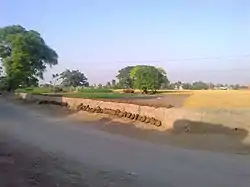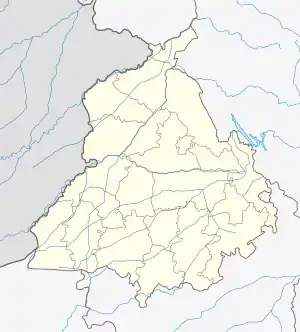Patti, Punjab
Patti is an Old City and a municipal council of the Tarn Taran district in the Majha region of Indian state of Punjab, located 47 Kilometres from Amritsar. Patti city also near of India bordering Pakistan. It is connected through rail starting from Amritsar station to Khem Karan station, with Khem Karan being its last station of India.
Patti | |
|---|---|
City | |
 Ghabdan Kothi Village, Patti | |
 Patti Location in Punjab, India  Patti Patti (India) | |
| Coordinates: 31.28°N 74.86°E | |
| Country | |
| State | Punjab |
| District | Tarn Taran |
| Government | |
| • Member of Parliament | Jasbir Singh Gill (Dimpa) (INC) |
| • Member of Legislative Assembly | Harminder Singh Gill (INC) |
| Elevation | 209 m (686 ft) |
| Population (2011)[1] | |
| • Total | 40,976 |
| Languages | |
| • Official | Punjabi[2] |
| Time zone | UTC+5:30 (IST) |
| PIN Code | 143416 |
| Telephone code | 01851[area code] |
| Vehicle registration | PB 38 |
Patti was a residence of Rai Duni Chand, a rich landlord, one of whose daughters, Bibi Rajni was a known devotee of Guru Ram Das Ji.[3] Mughal Governor of Punjab during Mughal period also lived in Patti. Before independence, Patti was a Tehsil of the Lahore district. The city houses the historic Mughal Fort and remains of the city wall. It also houses a number of other historical and religious places. Nowadays, Patti city is develop very rapidly. There are number of colleges and schools are built for leaners who go very far from their homes.
Etymology
Patti (Punjabi: ਪੱਟੀ) in Punjabi means kingdom area of king. The original name of this city was Patti Haibatpura or nou lakhi Patti, but over a certain period Patti became its name and stuck with it.[4] It was also known as 9 lakhi Patti, due to the wealth and revenue it generated during medieval days.patti is best known for saints
History
Patti is rich in history Before partition Patti was a tehsil of Lahore district. After Amritsar revenue district was split in two, it became a part of the newly created Tarn Taran district. Patti has been a power center and by some estimates it has been so for as long as 1000 years. In the medieval days it was known as 9 lakhi Patti. That means it generated high revenue of Rupees 9 Lakhs. The city has stories of a certain haveli, of its rulers Mirzas, which was destroyed for farming activity later on, as they migrated to Lahore (Pakistan) in 1947.[4]
The city is situated on a mound which adds to its altitude. To the south-east of the city is a smaller but higher mound which projects a Shiva Temple Shiva . Patti houses a fortress built in 1755 A.D. which housed the local police station up-till the year 2003.[4]
Patti finds rich references in the Sikh history especially when there were increased atrocities from declining mughals on Sikh Jatthedars (raiders) who looted the residents of the city. The fortress was used to prosecute rebellions. The tales of which became a part of everyday Sikh prayer.[4]
In the battle of misls, Patti was ultimately won by Faisailpuria(Singhpuria) Misl. Rumours suggest that Maharaja Ranjit Singh sent his army to siege the town when Mirza Talib Ali Baig rebelled against him for Sikh atrocities on Muslims, particularly banning of their call for prayer (Azan). During this siege, part of the outer wall was demolished.
Patti is also referenced as a place of the Pir (Sufism) and there were many houses of Pirs who belonged to Gillani's family. There are also shirines of Gillani's family [4] After partition of Indian and Pakistan in 1947, the Gillani family settled in the Pakistan.
Demographics
As of 2011 Indian Census, Patti had a total population of 40,976, of which 21,668 were males and 19,308 were females. The sex ratio is 891. Population within the age group of 0 to 6 years was 4,595. The total number of literates in Patti was 28,290, which constituted 69.0% of the population with male literacy of 72.6% and female literacy of 65.0%. The effective literacy rate of 7+ population of Patti was 77.8%, of which male literacy rate was 82.1% and female literacy rate was 72.9%. The Scheduled Castes population was 10,346. Patti had 7607 households in 2011.[1]
References
- "Census of India: Patti". www.censusindia.gov.in. Retrieved 5 December 2019.
- "52nd REPORT OF THE COMMISSIONER FOR LINGUISTIC MINORITIES IN INDIA" (PDF). Nclm.nic.in. Ministry of Minority Affairs. p. 32. Archived from the original (PDF) on 25 May 2017. Retrieved 30 August 2019.
- The Golden Temple Amritsar official site. http://www.goldentempleamritsar.org/places-to-visit-in-golden-temple-amritsar/dukh-bhanjani-beri.php
- Patti from kartarpur.com Archived 3 January 2010 at the Wayback Machine